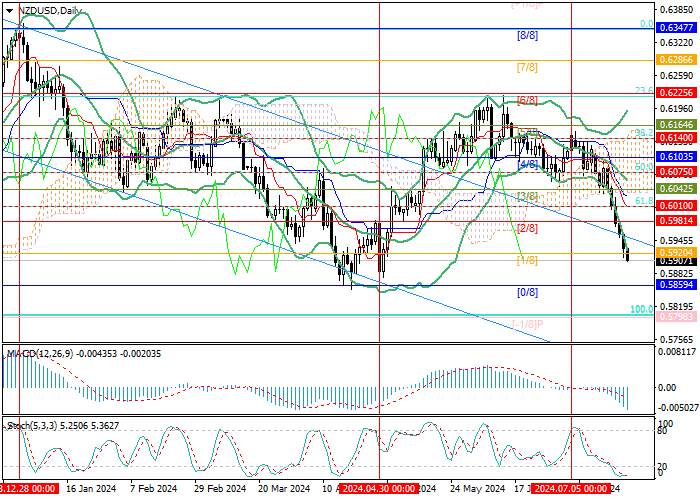Current trend
The NZD/USD pair has been declining since the beginning of this month and is currently testing the 0.5920 mark (Murrey level [1/8]): the US currency is pressured by expectations of the US Federal Reserve's imminent transition to a monetary policy easing cycle.
Investors are awaiting the publication of preliminary data on gross domestic product (GDP) for the second quarter and the June index of private consumption expenditures. The US economy may adjust from 1.4% to 2.0%, and private consumption spending from 2.6% to 2.5%, demonstrating a slowdown in inflationary pressure and accelerating the likelihood of a twofold adjustment in the cost of borrowing in September and December.
Experts, on the contrary, do not expect active actions from officials of the Reserve Bank of New Zealand (RBNZ) this year, since in the second quarter the consumer price index amounted to 3.3% YoY. It is also worth noting the publication on Monday of positive data on foreign trade for June: exports amounted to 6.17 billion New Zealand dollars, and imports amounted to 5.47 billion New Zealand dollars, while the trade surplus increased to 699.0 million New Zealand dollars. Nevertheless, significant pressure on the New Zealand currency is exerted by fears of a slowdown in the economy of China, one of the country's leading trading partners.
Thus, in the medium term, the continuation of the downward dynamics of the NZD/USD pair seems to be a more likely scenario.
Support and resistance
Technically, the asset has returned to the long-term descending channel and is now testing the 0.5920 mark (Murrey level [1/8]), consolidating below which will allow quotes to continue to decline towards the targets of 0.5859 (Murrey level [0/8]) and 0.5798 (Murrey level [1/8]). If the level of 0.5981 (Murrey level [2/8]) is broken up, the growth of the trading instrument may resume to 0.6075 (50.0% Fibonacci retracement, the central line of Bollinger Bands) and 0.6140 (38.2% Fibonacci retracement), but such a scenario seems less likely.
Technical indicators allow for a decrease: Bollinger Bands are reversing down, and MACD is increasing in the negative zone, while Stochastic entered the oversold zone, which does not exclude corrective growth, but its potential is seen to be limited.
Resistance levels: 0.5981, 0.6075, 0.6140.
Support levels: 0.5859, 0.5798.

Trading tips
Short positions should be opened from 0.5900 with targets of 0.5859, 0.5798 and stop-loss around 0.5930. Implementation period: 5–7 days.
Long positions can be opened above the 0.5981 mark with targets of 0.6075, 0.6140 and stop-loss around 0.5940.




Hot
No comment on record. Start new comment.